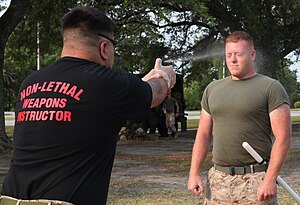This article needs additional citations for verification. (April 2022) |

Non-lethal weapons, also called nonlethal weapons, less-lethal weapons,[1][2][3][4] less-than-lethal weapons, non-deadly weapons, compliance weapons, or pain-inducing weapons are weapons intended to be less likely to kill a living target than conventional weapons such as knives and firearms with live ammunition. It is often understood that unintended or incidental casualties are risked wherever force is applied, however non-lethal weapons minimise the risk of casualties (e.g. serious/permanent injuries or death) as much as possible. Non-lethal weapons are used in policing and combat situations to limit the escalation of conflict where employment of lethal force is prohibited or undesirable, where rules of engagement require minimum casualties, or where policy restricts the use of conventional force. However, these weapons occasionally cause serious injuries or death due to allergic reactions, improper use and/or other factors; for this reason the term "less-lethal" has been preferred by some organizations as it describes the risks of death more accurately than the term "non-lethal", which some have argued is a misnomer.[2][5][6][7]
Non-lethal weapons may be used by conventional military in a range of missions across the force continuum. They may also be used by military police, by United Nations forces, and by occupation forces for peacekeeping and stability operations. Non-lethal weapons may also be used to channelize a battlefield, control the movement of civilian populations, or to limit civilian access to restricted areas (as they were utilized by the USMC's 1st Marine Expeditionary Force in Somalia in 1995). Similar weapons, tactics, techniques and procedures are employed by police forces domestically in riot control, prisoner control, crowd control, refugee control, and self-defense, where the terminology of "less-than-lethal" is often used.
- ^ Michigan State Police Training Manual 2012 (pp. 68-70): same effective definition for "Less-lethal weapons" as what DoDD 3000.03 (2013) has for "Non-lethal weapons"
- ^ a b Less Than Lethal Weapons, UN Peacekeeping PDT Standards for Formed Police Units 1st edition 2015 (PDF). 2015. Archived from the original (PDF) on 2021-08-16. Retrieved 2020-06-05.
- ^ United Nations Human Rights Guidance on Less-Lethal Weapons in Law Enforcement (PDF). 2020.
- ^ "Use of force, firearms and less lethal weapons". College of Policing. 2020. Retrieved 26 June 2020.
- ^ "There's No Such Thing as a 'Non-Lethal' Weapon". Vice.com. 21 October 2014. Retrieved 2022-05-05.
- ^ "No such thing as a non-lethal weapon". New Scientist. 185 (2489): 3. 2005. PMID 15839010.
- ^ "Taser and the Myth of Non-Lethal Weaponry – The Intercept". Theintercept.com. 2015-12-01. Retrieved 2022-05-05.